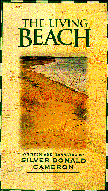
Volume 1 Number 12
September 1, 1995

|
The Living Beach.
Needham Gate Productions Ltd., 1994. VHS, 48 minutes.
Distributed by: Needham Gate Productions Ltd.,
P.O.Box 105, Falmouth, Nova Scotia, BOP 1L0 (902) 798-8777.
Grades 7 - 13 / Ages 11 - Adult
Review by Lorrie Andersen.
|
The Living Beach is a well-constructed video useful in
several curricular applications, including geography, language arts,
environmental studies, science, and social studies. The film covers the
topic of beaches from many angles: it interweaves commentary, excerpts
from famous pieces of literature, expert opinions from various
viewpoints, and glimpses of serious and playful uses of the beach, with
the story of human successes and failures in managing the waterfront.

With this video the viewer learns that even though it may shift and change position, the beach remains the same; ``beach erosion" should
really be called ``shoreline retreat." Even though the video shows
examples of engineering feats in, near, and around the water, the
production makes the point that in the end we have to let the beach do
what it wants to do, because attempts at engineering are ultimately
expensive and ineffective.
The beach moves and shifts by the action of storm and wave. Human
interaction with the beach comes with management schemes such as the
Sebastian Inlet Commission, which successfully manages an environmentally
sensitive area in Florida. The Living Beach also shows
(with the aid of diagrams) what sea walls accomplish in preserving the
beach -- as opposed to soft solutions that involve replenishing the
sediments that the oceans have redistributed.
Between 70 and 80 percent of Americans live within a one- or
two-hour drive to ocean or Great Lakes beaches. The resulting pressures
on this natural resource are intense, coming from recreational,
residential, industrial, and commercial demands. The Living
Beach ends with the comment that these beaches are sacred areas
-- things we can destroy but cannot create.
There are serious messages here, but also delightful quotes from
literature, ranging from Shakespeare to Robinson Crusoe,
with dashes from Mathew Arnold, Homer, Lord Byron, and even the famous
Second World War German field marshal Erwin Rommel. And there are tidbits of
useless, but nice-to-know information such as the ancient law in
Greenland regarding beachcombing. There's something on beaches for all
tastes here!
Although the producer is Canadian, the content is slanted almost
entirely to the United States, except for an example of an eroding
drumlin (a mound of glacial drift) in Nova Scotia, and the discussion on the role of summer cottage
life as a place for inter-generational family interaction.
The
Living Beach is not ideal for classroom use because of its length, but it would be a good purchase where there is a need for
materials on ``the way beaches grow and shrink and change" and about
``the human relationship with beaches -- why we love them, how we harm
them, and how they can harm us."
Recommended.
A librarian by training, Lorrie Andersen is Collection Development
Consultant, Instructional Resources, for Manitoba Education and
Training.
Copyright © 1995 the Manitoba Library Association.
Reproduction for personal use is permitted only if this copyright notice is
maintained. Any other reproduction is prohibited without permission.
Published by
The Manitoba Library Association
ISSN 1201-9364
 Go back to CM Welcome page
Go back to CM Welcome page
 Go back to Table of
Contents for this Issue
Go back to Table of
Contents for this Issue




 Go back to CM Welcome page
Go back to CM Welcome page
 Go back to Table of
Contents for this Issue
Go back to Table of
Contents for this Issue